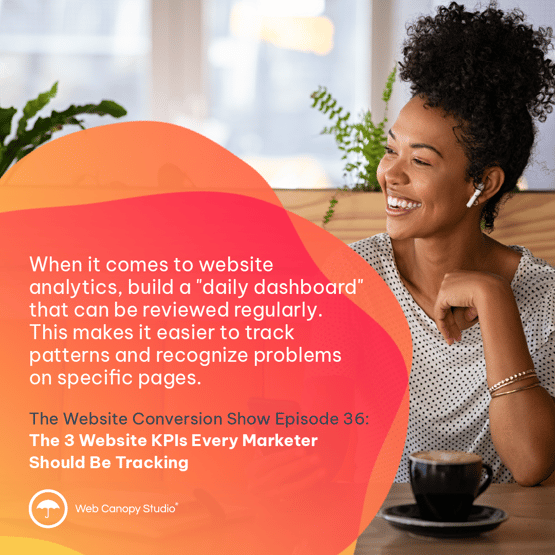Most marketers track numerous performance metrics on their websites, compiling visual representations of data on their dashboards. They have a report builder with hundreds or even thousands of different metrics you could put on a dashboard. It looks really cool and impressive, and if you dig around, you could probably find some things that are really important.
The problem is, many of these dashboards are built around vanity metrics; things that make you feel good because the little line goes up or the colored bars are taller. They look great, and they seem important, but they don't really tell you anything you need to know.
There are really only three important stats you need to track, three KPIs (key performance indicators), that tell you whether you're doing a good job marketing your company and website. These are the three website KPIs you should track.
1. Passing Leads vs. Lead Goals
The first KPI is pretty obvious. (At least I would hope so, but I've been surprised before.) That's passing leads to sales. As a marketer, I want to know how many contacts I'm sending to my sales team each month, and I want to track what's actually being passed versus the original goal. After all, sales are what keep the company going, and my marketing efforts lead directly to that. So I should know whether I'm being successful.
The most common definition of a hot lead — and the one we'll use here — is a marketing-qualified lead (MQL). An MQL is someone who has been engaged a lot. They've engaged with what you're doing, they've read blogs and emails, they've attended your webinars, visited you at trade shows and conferences, and they're a good fit for your product or service.
You'd need some kind of trigger or threshold that will pass that person to the sales team, but this is where you can use automation features in Hubspot or your favorite marketing CRM. Or you can just manually identify each lead and pass them to sales yourself. Regardless of how you do it, make sure you have an agreed-upon definition of what qualifies as an MQL.
You also need to set a goal for each month's leads so you can analyze your marketing campaigns and see whether you're being effective. If your goal is 20 leads per month and you're only passing 10 to the sales team, then you know you need to make some improvements.
Comparing your leads goal to your actual passed leads will tell you that you have things to work on. Maybe it's your lead nurturing, maybe it's the total website traffic, or maybe you need to engage your existing contacts more. As you make changes to your program, you can see whether you're meeting your goals and improving or sliding backward.

2. Track your Failed Leads
Tracking your MQLs also help you identify leads that no longer work or that the sales team can't close on. Typically, once the sales team can't work a lead anymore, it just disappears. Maybe it hits a separate list that gets revisited every six months or even a year. But for the most part, it's like there's a one-way street of marketing contacts that never seem to go anywhere.
So it's important these dead leads get passed back to the marketing department so they can be aware that it's no longer valid. It's important to track these for your own metrics.
One thing we do here is to tag these returned leads and analyze them. We go through every single lead and ask "What happened? Why didn't this close?" Was it something we did? Did we qualify the wrong lead? Did we fail somehow? Or is it something the sales team did?" It's important to know why a lead died on the vine, rather than just shrugging and saying, "Oh, well."
If we're being told they're just a bad fit, then we need to dive into that. We'll pull out so much data from 10, 20, or 30 of these leads, and that will inform us that we have a gap or that something is missing in the marketing process. Maybe we're not getting the leads early enough, or the time to contact is not fast enough, or maybe the funnel process is too long or too short. But we can only know that if we receive the failed leads back from the sales department so we can analyze them.

3. Break Down Your Conversion Rate
If you're using HubSpot or another CRM, you already have a landing page report that you could analyze. It's just a standard report that shows all of your landing pages and your forms. You want to track all the pages and places that people could convert, and you want it in list form. You want to see the individual visitors each month to those pages, and filter by most frequently visited. And you want to see the conversion rate for each page as well.
You especially want this in a quick dashboard that you can regularly review, to look at it every day just to see what's going on. The goal is to track patterns and see which pages are doing well and which ones need work.
You can be as complex as you want, and make cool reports and graphs that cover 30, 60, or 90 days or more. You want to see a visual representation of the conversion rates, but you especially want to see the individual pages. That way, you can identify the ones that are the problems, and the ones that are performing at a high level. This way, you can see what works so you can do more of it, and you can see what's failing so you know what to fix.
There are a lot of metrics just baked into a lot of different software, and they're interesting to know, but a lot of people just throw dashboards together because they think they look interesting. But they have to step back and ask themselves, "what am I really trying to understand? What am I really trying to see? What shows me whether I'm being successful in my marketing efforts." Then build your reports and dashboards around that.
These are the three KPIs every marketer should track right, regardless of whatever else you monitor. If your platform cannot do these things, you may want to switch platforms. If you don't have this kind of clarity, you're really missing the mark and potentially leaving a lot of money on the table.
To learn more about your conversion rate assessment, take the website conversion assessment and walk through the website questions. We have five different questions for six different categories of the website conversion framework. Your answers will create an automated report that gives you a checklist of things to improve your website.



